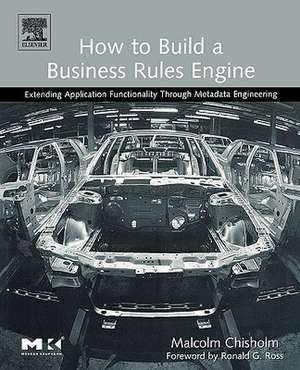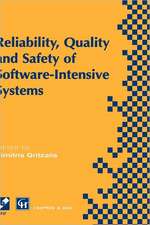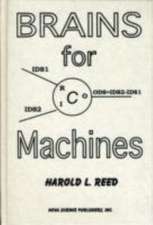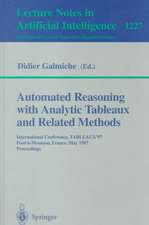How to Build a Business Rules Engine: Extending Application Functionality through Metadata Engineering: The Morgan Kaufmann Series in Data Management Systems
Autor Malcolm Chisholmen Limba Engleză Paperback – 13 ian 2004
·A sample application is used throughout the book to illustrate concepts. The code for the sample application is available online at http://www.refdataportal.com.
·Includes conceptual overview chapters suitable for management-level readers, including general introduction, business justification, development and implementation considerations, and more.
·This is the only book that demonstrates how to develop a business rules engine. Covers user requirements, data modeling, metadata, and more.
·A sample application is used throughout the book to illustrate concepts. The code for the sample application is available online at http://www.refdataportal.com.
·Includes conceptual overview chapters suitable for management-level readers, including general introduction, business justification, development and implementation considerations, and more.
Din seria The Morgan Kaufmann Series in Data Management Systems
- 34%
 Preț: 392.54 lei
Preț: 392.54 lei - 36%
 Preț: 310.89 lei
Preț: 310.89 lei - 20%
 Preț: 549.28 lei
Preț: 549.28 lei - 20%
 Preț: 423.79 lei
Preț: 423.79 lei - 20%
 Preț: 453.27 lei
Preț: 453.27 lei - 20%
 Preț: 557.64 lei
Preț: 557.64 lei - 20%
 Preț: 861.54 lei
Preț: 861.54 lei - 20%
 Preț: 750.58 lei
Preț: 750.58 lei - 20%
 Preț: 589.11 lei
Preț: 589.11 lei - 20%
 Preț: 398.97 lei
Preț: 398.97 lei - 20%
 Preț: 553.31 lei
Preț: 553.31 lei - 35%
 Preț: 243.25 lei
Preț: 243.25 lei - 20%
 Preț: 402.52 lei
Preț: 402.52 lei - 20%
 Preț: 449.34 lei
Preț: 449.34 lei - 20%
 Preț: 827.30 lei
Preț: 827.30 lei - 31%
 Preț: 237.87 lei
Preț: 237.87 lei - 20%
 Preț: 268.09 lei
Preț: 268.09 lei - 20%
 Preț: 560.60 lei
Preț: 560.60 lei - 20%
 Preț: 517.90 lei
Preț: 517.90 lei - 20%
 Preț: 398.74 lei
Preț: 398.74 lei - 20%
 Preț: 628.30 lei
Preț: 628.30 lei - 20%
 Preț: 476.28 lei
Preț: 476.28 lei - 20%
 Preț: 148.30 lei
Preț: 148.30 lei - 20%
 Preț: 782.30 lei
Preț: 782.30 lei - 20%
 Preț: 869.95 lei
Preț: 869.95 lei - 20%
 Preț: 941.84 lei
Preț: 941.84 lei - 16%
 Preț: 184.00 lei
Preț: 184.00 lei - 30%
 Preț: 301.70 lei
Preț: 301.70 lei - 20%
 Preț: 648.76 lei
Preț: 648.76 lei - 20%
 Preț: 367.92 lei
Preț: 367.92 lei - 20%
 Preț: 606.38 lei
Preț: 606.38 lei - 20%
 Preț: 612.63 lei
Preț: 612.63 lei - 20%
 Preț: 665.15 lei
Preț: 665.15 lei - 20%
 Preț: 505.62 lei
Preț: 505.62 lei - 20%
 Preț: 617.57 lei
Preț: 617.57 lei - 20%
 Preț: 550.29 lei
Preț: 550.29 lei - 20%
 Preț: 563.24 lei
Preț: 563.24 lei - 29%
 Preț: 379.06 lei
Preț: 379.06 lei - 33%
 Preț: 278.29 lei
Preț: 278.29 lei - 32%
 Preț: 189.98 lei
Preț: 189.98 lei - 32%
 Preț: 281.67 lei
Preț: 281.67 lei - 20%
 Preț: 455.09 lei
Preț: 455.09 lei - 20%
 Preț: 466.95 lei
Preț: 466.95 lei - 20%
 Preț: 512.32 lei
Preț: 512.32 lei - 20%
 Preț: 231.88 lei
Preț: 231.88 lei - 8%
 Preț: 355.29 lei
Preț: 355.29 lei
Preț: 584.49 lei
Preț vechi: 730.61 lei
-20% Nou
Puncte Express: 877
Preț estimativ în valută:
111.84€ • 117.08$ • 92.54£
111.84€ • 117.08$ • 92.54£
Carte tipărită la comandă
Livrare economică 05-19 aprilie
Preluare comenzi: 021 569.72.76
Specificații
ISBN-13: 9781558609181
ISBN-10: 1558609180
Pagini: 512
Ilustrații: 1, black & white illustrations
Dimensiuni: 187 x 235 x 27 mm
Greutate: 0.84 kg
Editura: ELSEVIER SCIENCE
Seria The Morgan Kaufmann Series in Data Management Systems
ISBN-10: 1558609180
Pagini: 512
Ilustrații: 1, black & white illustrations
Dimensiuni: 187 x 235 x 27 mm
Greutate: 0.84 kg
Editura: ELSEVIER SCIENCE
Seria The Morgan Kaufmann Series in Data Management Systems
Public țintă
database designers, data modelers, database administrators, software engineers, systems architects, project leader, project manager, programmer, and other IT staffCuprins
What
Are
Business
Rules
and
Business
Rules
Engines.
Why
Build
a
Business
Rules
Engine.
Data
Modeling
and
Database
Design.
Who
Defines
Business
Rules
and
When
Do
They
Do
It.
The
Atomicity
of
Business
Rules.
The
"Black
Box"
Problem.
The
Components
of
a
Business
Rules
Engine.
Populating
Table
Data
in
the
Repository.
Populating
Column
Data
in
the
Repository.
Populating
Relationship
and
Subtype
Data
in
the
Repository.
Populating
Reference
Data
in
the
Repository.
Defining
Business
Processes
and
Related
Information.
Extending
the
Database.
Managing
the
Database.
Implementing
a
Simple
Business
Rule.
More
Edit
Validation
Rules,
Rule
Components,
and
Rule
Versions.
Rule
Types
for
Checking
Referential
Integrity.
Working
with
Batch
Processes:
Setting
Indicators
and
Reference
Data
Code
Values.
Implementing
Rule
Types
Using
Relationships
and
Subtipes.
Rules
with
Subtypes
and
Business
Metadata.
Debugging
in
Business
Rules
Engines.
Managing
the
Business
Rules
Engine.
Appendix
A:
Using
the
Sample
Application.























